现在分词作状语的分类(伴随、让步、条件、时间等等)
现在分词作状语有几种形式有用课件

独立式现在分词作状语
总结词
强调动作的独立性和完整性
详细描述
独立式现在分词作状语时,通常强调动作的独立性和完整性。例如,在句子“Sitting at the table, he started to read his book.”中,“Sitting at the table”是独立式现在分词作状语,强调了他坐 在桌子旁开始读书的动作独立于主句,且具有完整性。
动词不定式作状语
总结词
表达目的、原因等意义,增强句子丰富性
详细描述
动词不定式作状语时,通常表示目的、原因等意义,增强了句子的丰富性。例如 ,在句子“To pass the exam, she spent all night studying.”中,“To pass the exam”是动词不定式作状语,表示她花费一整晚学习是为了通过考试。
要点二
结果
使用现在分词作状语可以表达某个事件或动作发生后的结 果。例如,“他讲了一个笑话,大家都笑了起来。”
04
现在分词作状语与其它结 构区别
与独立主格结构区别
独立主格结构
不能单独使用,需要与主句共用一个主语, 常用于描述伴随状况或补充说明。
现在分词作状语
可以单独使用,表达的动作与主句的主语一 致,通常用于描述原因、方式或伴随状况。
03
现在分词作状语的有用性
表达时间关系
时间名词
使用现在分词作状语可以更清晰地表达某个事件或动作发生 的时间点或时间段。例如,“正在跑步的时候,突然下起了 雨。”
描述先后顺序
使用现在分词作状语可以描述两个或多个事件或动作之间的 先后顺序关系。例如,“完成作业后,我开始准备晚餐。”
描述伴随状况
伴随状况
现在分词作状语

且和谓语动词同时发生,则用分词 的一般形式. • He was ill and didn’t attend the meeting.
• =Being ill, he didn’t attend the meeting.
• ⑵如果分词表示的是一个极短暂的
动作,这动作一发生,谓语表示的动 作立即发生,也用分词的一般形式. • Hearing the news, they all jumped with joy.
2. ________the piano, someone suddenly knocked at the door.
A. Playing
B. When I was playing
C. Repairing
D. Examining
3. Mother caught the boy ______ in the
可以表示时间原因结果条件行可以表示时间原因结果条件行为方式或伴随动作等
现在分词作状语
-ing分词作状语可以表 示时间、原因、结果、 条件、让步、方式或伴 随情况等。
While Reading the book, he nodded from time to time. 他一边看书,一边不时地点头。 After having dinner, she went out for a walk. 吃完晚饭,她出去散步。
3). Walking in the street, I saw a tailor’s shop. 时间
When I was walking in the street.
4). His father died, leaving the family even worse off. 结果
现在分词用作状语(九类)
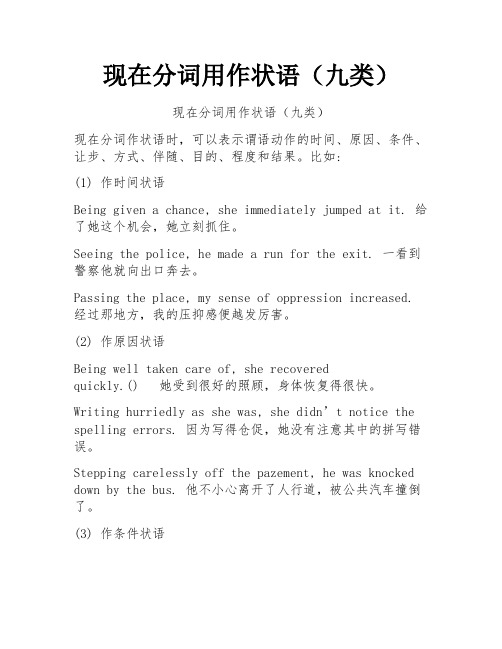
现在分词用作状语(九类)现在分词用作状语(九类)现在分词作状语时,可以表示谓语动作的时间、原因、条件、让步、方式、伴随、目的、程度和结果。
比如:(1) 作时间状语Being given a chance, she immediately jumped at it. 给了她这个机会,她立刻抓住。
Seeing the police, he made a run for the exit. 一看到警察他就向出口奔去。
Passing the place, my sense of oppression increased. 经过那地方,我的压抑感便越发厉害。
(2) 作原因状语Being well taken care of, she recoveredquickly.() 她受到很好的照顾,身体恢复得很快。
Writing hurriedly as she was, she didn’t notice the spelling errors. 因为写得仓促,她没有注意其中的拼写错误。
Stepping carelessly off the pazement, he was knocked down by the bus. 他不小心离开了人行道,被公共汽车撞倒了。
(3) 作条件状语Being advised to talk less, Mary keeps silent while we talk. 要是叫她少说点,当我们说话的时候,玛丽就会保持沉默。
It will take you half an hour to get to the station, allowing for traffic delays. 把路上的耽搁算进去,你要用半小时才能到车站。
Being defeated in every battle, the enemy will soon surrender. 要是敌人每场战斗都被打败,那他们就会投降。
现在分词作状语

注意1:
分词(短语)做状语时,分词前面可以 加上连词,但是分词和句子之间不能用 并列连词(如but,and,so),因为并列连 词接的是两个并列成分,而分词短语只 是全句的一个状语部分,分词和主句之 间可用逗号。
例如:
误: Having been told many times, but he still couldn’t understand it.
having been done
He came into the classroom, talking and laughing.
doing 作状语,表示分词的动作与谓 语动作同时发生
Having finished his work, he went home.
having done 作状语,表示分词的动作先 于谓语的动作发生
B.过去分词作状语学与练
把下列划线部分改写成分词短语, 并 说明其功能
1.When she was asked why she did it, she began to cry.
*从句的动词用的是被动语态 *Asked why she did it, she began to cry.*过去分词短语作时间状语
Generally speaking, girls are more careful than boys
分词作状语
现在分 词
状关系
其 逻辑 主语必 须与句子 主语保持一致
Hearing the bad news, they couldn’t help crying.
When they heard the
doing bad news
与主语为 主动关系
Given more attention, the trees could have grown better.
现在分词短语作状语要点总结
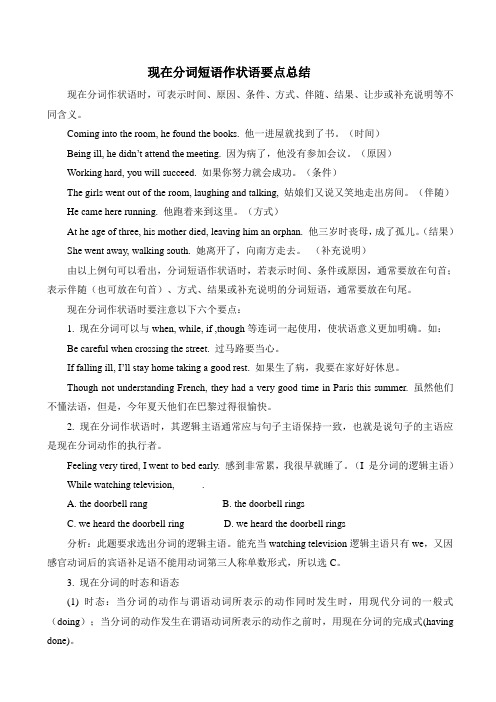
现在分词短语作状语要点总结现在分词作状语时,可表示时间、原因、条件、方式、伴随、结果、让步或补充说明等不同含义。
Coming into the room, he found the books. 他一进屋就找到了书。
(时间)Being ill, he didn’t attend the meeting. 因为病了,他没有参加会议。
(原因)Working hard, you will succeed. 如果你努力就会成功。
(条件)The girls went out of the room, laughing and talking, 姑娘们又说又笑地走出房间。
(伴随)He came here running. 他跑着来到这里。
(方式)At he age of three, his mother died, leaving him an orphan. 他三岁时丧母,成了孤儿。
(结果)She went away, walking south. 她离开了,向南方走去。
(补充说明)由以上例句可以看出,分词短语作状语时,若表示时间、条件或原因,通常要放在句首;表示伴随(也可放在句首)、方式、结果或补充说明的分词短语,通常要放在句尾。
现在分词作状语时要注意以下六个要点:1. 现在分词可以与when, while, if ,though等连词一起使用,使状语意义更加明确。
如:Be careful when crossing the street. 过马路要当心。
If falling ill, I’ll stay home taking a good rest. 如果生了病,我要在家好好休息。
Though not understanding French, they had a very good time in Paris this summer. 虽然他们不懂法语,但是,今年夏天他们在巴黎过得很愉快。
2. 现在分词作状语时,其逻辑主语通常应与句子主语保持一致,也就是说句子的主语应是现在分词动作的执行者。
现在分词作状语的分类(伴随、让步、条件、时间等等)
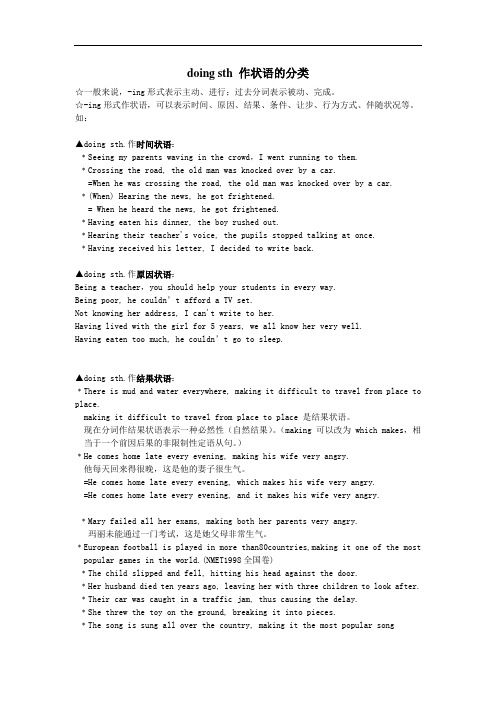
doing sth 作状语的分类☆一般来说,-ing形式表示主动、进行;过去分词表示被动、完成。
☆-ing形式作状语,可以表示时间、原因、结果、条件、让步、行为方式、伴随状况等。
如:▲doing sth.作时间状语:﹡Seeing my parents waving in the crowd,I went running to them.﹡Crossing the road, the old man was knocked over by a car.=When he was crossing the road, the old man was knocked over by a car.﹡(When) Hearing the news, he got frightened.= When he heard the news, he got frightened.﹡Having eaten his dinner, the boy rushed out.﹡Hearing their teacher's voice, the pupils stopped talking at once.﹡Having received his letter, I decided to write back.▲doing sth.作原因状语:Being a teacher,you should help your students in every way.Being poor, he couldn’t afford a TV set.Not knowing her address, I can't write to her.Having lived with the girl for 5 years, we all know her very well.Having eaten too much, he couldn’t go to sleep.▲doing sth.作结果状语:﹡There is mud and water everywhere, making it difficult to travel from place to place.making it difficult to travel from place to place 是结果状语。
现在分词作状语

4. Lots of rescue workers were working around the clock, _____ supplies to Yushu, Qinghai Province after the earthquake. (福建2010) A. sending B. to send C. having sent D. to have sent
Having been translated ______________________into many languages, the book was widely read all over the world. ( translate ) Having finished _____________his homework , he went to bed. ( finish )
T
Practice
单句改错
1. Having not seen the film, I can’t tell you what I think of it. Not having 2. The men worked for extra hours got an extra pay. working 3. Seen from the top of the hill, we find the city more beautiful. Seeing 4. Generally speak, facial expressions are helpful communications, too. speaking
5. “Can’t you read?” the man said, angrily pointed to the notice on the wall. pointing 6. Knocking at the door before entering, please. Knock 7. European football is played in 80 countries, made it the most popular sport in the world. making
现在分词做状语

语法一:现在分词做状语现在分词(动词的ing 形式)做状语时,通常都表示主语正在进行的另一动作,其逻辑主语必须与句子的主语保持一致,且必须与句子的主语是逻辑上的主谓关系;动词的ing形式表示的动作是次要动作。
现在分词可以做时间,条件,结果,让步,方式等状语。
相当于相应的状语从句。
作时间,原因或条件时,通常位于主句前面,作方式,伴随或结果状语时,通常位于主句后面。
如果分词所表示的动作和谓语的动作同时发生或几乎同时发生,用现在分词的一般式。
如果分词动作明显在谓语动词之前发生,用现在分词的完成式。
(having done),在作时间状语的分词前,可加连词while, when,介词after, before, on等。
一. 做伴随状语:分词等于and连接两个动词或分句。
1:The dog came in. It followed its master. =The dog came in, following its master.2:The children ran out of the room, laughing and talking merrily.3:They stood there for an hour, watching the game.二.原因状语相当于as, since, because等引起的原因状语从句,常位于句首,句中或句末。
1. He was a brave man. He decided to return to France. = Being a brave man, he decided to return to France.2:Seeing nobody at home, she decided to leave them a note.3:No t knowing her address, we couldn‟t get in touch with her.4:Being so poor in those days, we couldn‟t afford to send the boy to hospital.5.Having worked among the peasants for many years, he knew them very well.6. Not having received an answer, he decided to write another letter.三.时间状语,相当于when, while ,as 等引导的时间状语从句,常位于句首或句末。
高中英语知识点归纳分词作状语的常见形式
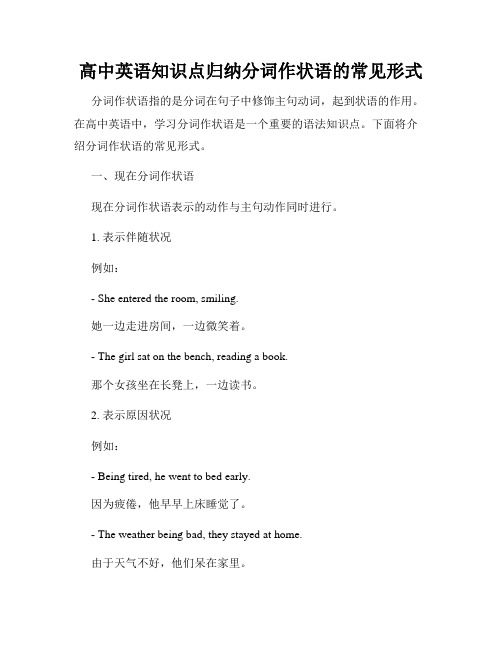
高中英语知识点归纳分词作状语的常见形式分词作状语指的是分词在句子中修饰主句动词,起到状语的作用。
在高中英语中,学习分词作状语是一个重要的语法知识点。
下面将介绍分词作状语的常见形式。
一、现在分词作状语现在分词作状语表示的动作与主句动作同时进行。
1. 表示伴随状况例如:- She entered the room, smiling.她一边走进房间,一边微笑着。
- The girl sat on the bench, reading a book.那个女孩坐在长凳上,一边读书。
2. 表示原因状况例如:- Being tired, he went to bed early.因为疲倦,他早早上床睡觉了。
- The weather being bad, they stayed at home.由于天气不好,他们呆在家里。
3. 表示条件状况例如:- I will go to the park, weather permitting.天气允许的话,我会去公园。
- We went out, the rain having stopped.雨停了,我们出去了。
4. 表示方式、手段状况例如:- He ran to the bus stop, hoping to catch the bus.他跑到公交车站,希望能赶上公交车。
- The boy solved the math problem, using the formula he had learned.这个男孩用他学过的公式解了这个数学问题。
二、过去分词作状语过去分词作状语表示的动作发生在主句动作之前。
1. 表示时间状况例如:- Having finished his homework, he went out to play.他完成了作业后,出去玩了。
- We arrived at the airport, having missed the flight.我们到达机场时,航班已经错过了。
现在分词作状语

常
见 •Lost in thought ,….
Compared with Shanghai,…. 分 Encouraged by his words,…. 词 Aborbed in a novel,…… Caught in the rain,…. Seated in the back,…. Seriously injured in the leg,…..
D
Practice :
3. _________ the last bus , he had to go home by taxi. A Not catching B Catching not C Having not caught D Not having caught
D
Practice :
4. ________ at night , the cry of the wolf made everyon ________. A Hearing … frightening B Hearing ….frightened C Heard…..frightening D Heard….frightened
doing/ done having done/ having been done
分词或分词短语作状语时, 时间, 分词或分词短语作状语时,可以表示时间, 原因,让步,条件, 原因,让步,条件,方式或伴随状语。 通常可以转换成相应的状语从句。
时间状语
When I saw the professor, I said hello to him.= Seeing _____________the professor , I said hello to him.= When _________ the professor, I said Seeing hello to him.
现在分词在句子中作状语的用法介绍

现在分词在句子中作状语的用法介绍你知道现在分词在句子中的用法吗?下面是小编收集的现在分词在句子中作状语的用法介绍。
欢迎阅读!一、分词在句子中作状语,可以表示时间、条件、原因、结果、让步、伴随等。
分词(短语)作状语时,其逻辑主语应与句中主语相一致。
当现在分词表示的动作发生在谓语动词之前时, 则用现在分词的完成式;当所表示的动作与谓语的动作同时发生, 则用现在分词的一般式。
完成或被动关系用过去分词。
二、现在分词作状语时,其逻辑主语应该与句子的主语一致,但有时现在分词的主语与其所在句中的主语并不一致,这种现在分词即所谓的`垂悬现在分词。
垂悬现在分词容易使句意模糊,甚至造成歧义,因而通常被认为是不合规范或错误的用法。
1.Searching along the deck,it had taken him some time to find a doctor.他沿着甲板找了好久才找到一名医生。
(searching的逻辑主语是句中的him)2.Walking or sleeping,this subject was always in my mind.不论是走路或睡觉,我总是在想着这个问题。
(walking or sleeping的逻辑主语是句中的my)3.Traveling is interesting but tiring.旅行是有趣的,但是使人疲劳4.The pupils will get confused if they are made to learn too much.如果让学生学得太多,他们会感到糊涂的。
5.The argument is very convincing.他的论点很令人信服。
6.They were very excited at the news.听到这个消息,他们非常激动。
三、现在分词或过去分词作状语时,有时可以在分词前加while,when, once, although, until, if等连词。
1 现在分词、过去分词、不定式做状语讲解
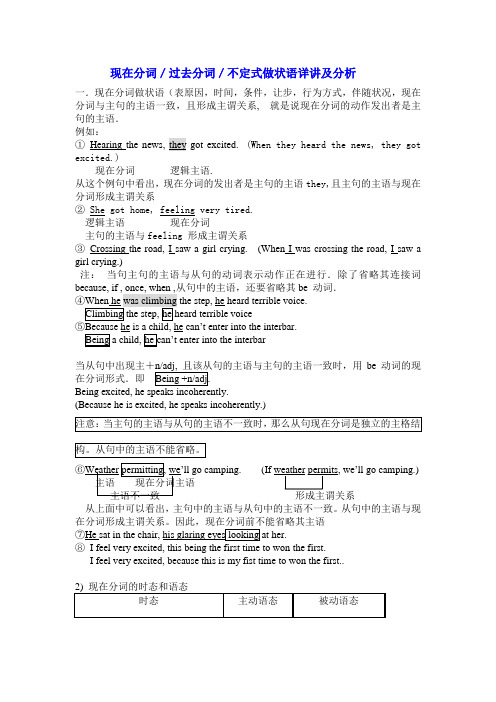
现在分词/过去分词/不定式做状语详讲及分析一.现在分词做状语(表原因,时间,条件,让步,行为方式,伴随状况,现在分词与主句的主语一致,且形成主谓关系,就是说现在分词的动作发出者是主句的主语.例如:①Hearing the got excited. (When they heard the news, they got excited.)现在分词逻辑主语.从这个例句中看出,现在分词的发出者是主句的主语they,且主句的主语与现在分词形成主谓关系② She got home, feeling very tired.逻辑主语现在分词主句的主语与feeling 形成主谓关系③Crossing the road, I saw a girl crying. (When I was crossing the road, I saw a girl crying.)注:当句主句的主语与从句的动词表示动作正在进行.除了省略其连接词be 动词.When he was climbing the step, he heard terrible voice.Because he is a child, he can’t enter into the interbar.’t enter into the interbarbe 动词的现在分词形式.即Being excited, he speaks incoherently.(Because he is excited, he speaks incoherently.)ll go camping. ’ll go camping.)从上面中可以看出,主句中的主语与从句中的主语不一致。
从句中的主语与现在分词形成主谓关系。
因此,现在分词前不能省略其主语⑦He sat in the chair, his glaring eyes looking at her.⑧I feel very excited, because this is my fist time to won the first..①(knowing为一般式)②从上句的句意中得知,买票的动作发生在进电影院之前。
现在分词作状语 英语
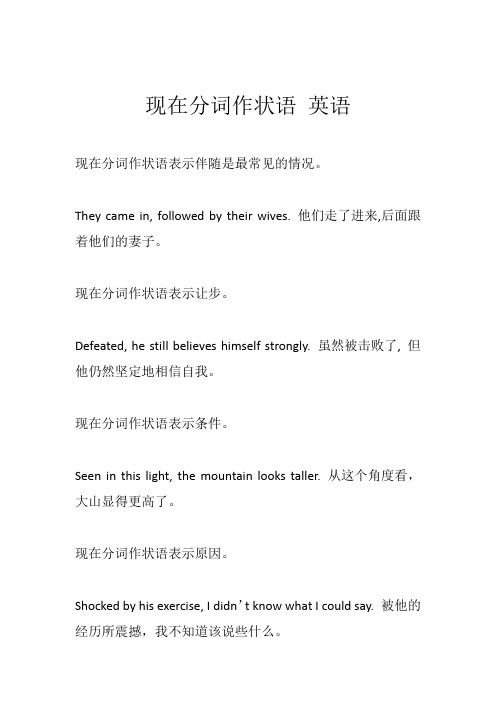
现在分词作状语英语
现在分词作状语表示伴随是最常见的情况。
They came in, followed by their wives. 他们走了进来,后面跟着他们的妻子。
现在分词作状语表示让步。
Defeated, he still believes himself strongly. 虽然被击败了, 但他仍然坚定地相信自我。
现在分词作状语表示条件。
Seen in this light, the mountain looks taller. 从这个角度看,大山显得更高了。
现在分词作状语表示原因。
Shocked by his exercise, I didn’t know what I could say. 被他的经历所震撼,我不知道该说些什么。
现在分词作状语表示时间。
Asked why he came late, he said that got up late.
当他被问到为什么来晚了时,他说他起床起晚了。
现在分词作状语表示方式。
He supports his family driving a taxi. 他靠开出租供养家庭。
现在分词作状语表示结果。
The mother died of disease leaving two young children. 这位母亲死于疾病,留下了两个年幼的孩子。
现在分词作状语用
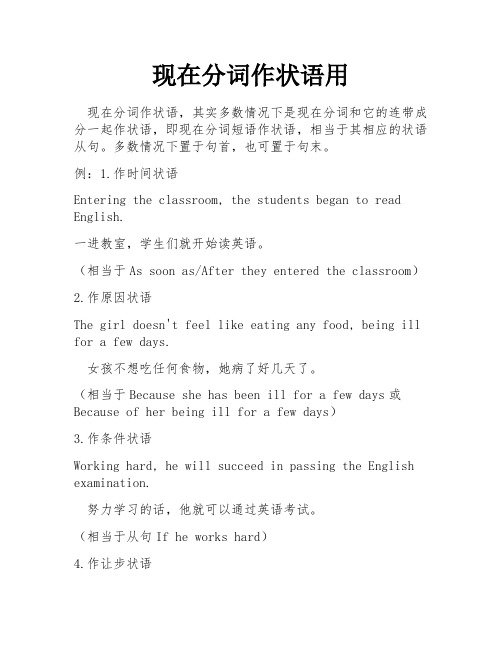
现在分词作状语用现在分词作状语,其实多数情况下是现在分词和它的连带成分一起作状语,即现在分词短语作状语,相当于其相应的状语从句。
多数情况下置于句首,也可置于句末。
例:1.作时间状语Entering the classroom, the students began to read English.一进教室,学生们就开始读英语。
(相当于As soon as/After they entered the classroom)2.作原因状语The girl doesn't feel like eating any food, being ill for a few days.女孩不想吃任何食物,她病了好几天了。
(相当于Because she has been ill for a few days或Because of her being ill for a few days)3.作条件状语Working hard, he will succeed in passing the English examination.努力学习的话,他就可以通过英语考试。
(相当于从句If he works hard)4.作让步状语Being tired after work, he still insists on studying French.下班后很累,他任然坚持学习法语。
(相当于Though he is tired after work或Though tired after work)5.作结果状语People all over the world sing the song, making it popular.全世界的人都唱这首歌,使它流行了起来。
(相当于so that they make it popular)6.作方式状语Travelling by car , we enjoyed many beautifull places.乘车旅行,我们欣赏了很多优美地方。
现在分词做伴随状语
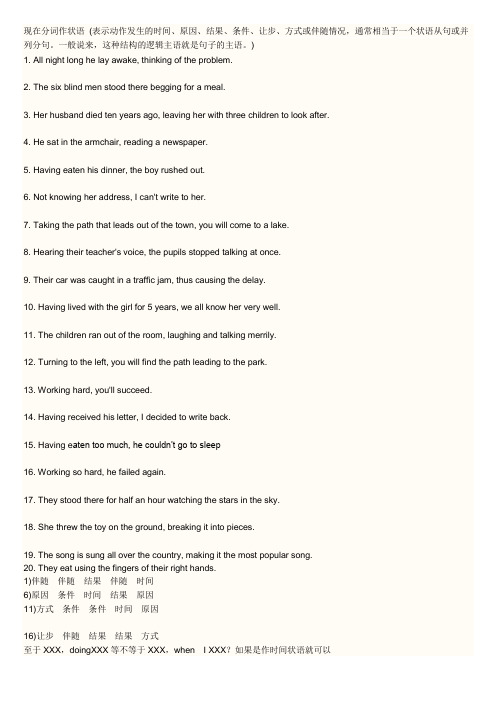
现在分词作状语(表示动作发生的时间、原因、结果、条件、让步、方式或伴随情况,通常相当于一个状语从句或并列分句。
一般说来,这种结构的逻辑主语就是句子的主语。
)1. All night long he lay awake, thinking of the problem.2. The six blind men stood there begging for a meal.3. Her husband died ten years ago, leaving her with three children to look after.4. He sat in the armchair, reading a newspaper.5. Having eaten his dinner, the boy rushed out.6. Not knowing her address, I can't write to her.7. Taking the path that leads out of the town, you will come to a lake.8. Hearing their teacher's voice, the pupils stopped talking at once.9. Their car was caught in a traffic jam, thus causing the delay.10. Having lived with the girl for 5 years, we all know her very well.11. The children ran out of the room, laughing and talking merrily.12. Turning to the left, you will find the path leading to the park.13. Working hard, you'll succeed.14. Having received his letter, I decided to write back.15. Having e aten too much, he couldn’t go to sleep16. Working so hard, he failed again.17. They stood there for half an hour watching the stars in the sky.18. She threw the toy on the ground, breaking it into pieces.19. The song is sung all over the country, making it the most popular song.20. They eat using the fingers of their right hands.1)伴随伴随结果伴随时间6)原因条件时间结果原因11)方式条件条件时间原因16)让步伴随结果结果方式至于XXX,doingXXX等不等于XXX,when I XXX?如果是作时间状语就可以。
现在分词作状语的用法
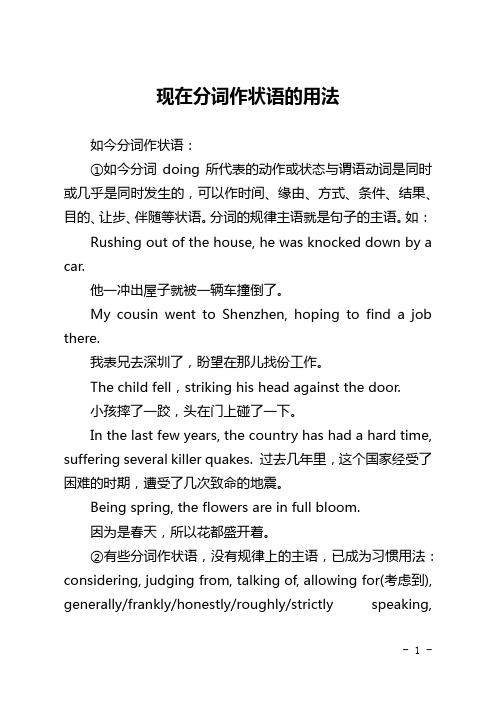
现在分词作状语的用法如今分词作状语:①如今分词doing所代表的动作或状态与谓语动词是同时或几乎是同时发生的,可以作时间、缘由、方式、条件、结果、目的、让步、伴随等状语。
分词的规律主语就是句子的主语。
如:Rushing out of the house, he was knocked down by a car.他一冲出屋子就被一辆车撞倒了。
My cousin went to Shenzhen, hoping to find a job there.我表兄去深圳了,盼望在那儿找份工作。
The child fell,striking his head against the door.小孩摔了一跤,头在门上碰了一下。
In the last few years, the country has had a hard time, suffering several killer quakes. 过去几年里,这个国家经受了困难的时期,遭受了几次致命的地震。
Being spring, the flowers are in full bloom.因为是春天,所以花都盛开着。
②有些分词作状语,没有规律上的主语,已成为习惯用法:considering, judging from, talking of, allowing for(考虑到), generally/frankly/honestly/roughly/strictly speaking,assuming that(假设)等。
如:Talking of this film, its wonderful.说到这部电影,好极了。
Assuming that it is true, what should we do now假定那是真的, 我们如今该怎麽办Judging by the direction of the wind, it wont rain today.依据风向测度, 今日不会下雨。
现在分词作状语

4.作结果状语 现在分词作结果状语时,通常放在句末,中间用逗号隔 开,表示一种顺其自然、意料之中的结果。 The fire lasted a whole night,causing great damage. 大火持续了一整夜,造成了巨大损失。 [名师点津] 现在分词作结果状语,是随着谓语动词的发 生而产生的自然结果,其逻辑主语往往是前面整个句子 所描述的情况,前面有时候可以加thus。而不定式作结果 状语时常表示出乎意料的结果,常用only to do结构其被 动形式为only to be done。
ห้องสมุดไป่ตู้
二、现在分词作状语注意事项 1.现在分词的时态
现在分词作状语时,要注意分词的时间性,是用现在分 词的一般式(doing),还是用完成式(having done)。 (1)当现在分词的动作与谓语动词的动作同时发生时,用 分词的一般式。 Walking in the street,I met an old friend of mine. 我正在大街上行走时,遇到了一位老朋友。(walking和谓 语动词met同时发生)
3.动词ing形式的否定式:not+v.ing;not having+v.ed Not knowing this,he didn't come. 他不知道这件事,所以没来。 Not having made full preparations,we put off the sports meeting. 因为没有做好充分的准备,我们把运动会延期了。
Part Ⅱ Grammar——现在分词作状语
[思维导图]
一、现在分词作状语的用法 现在分词(短语)在句中作状语用来修饰谓语动词或整个
句子,表示动作发生的时间、原因、条件、结果、方式、让 步或伴随状况。
现在分词做伴随状语

Thank you
找出现在分词做伴随状语的句子:
On the Lunar New Year Eve, we all gather together, having a big family reunion dinner. Then follows the Spring Gala, in the evening the whole family are sitting together, watching TV, when many a star will turn up on the stage, bringing us so much pleasure that we are drowned in admiring their performances. Meanwhile, many people stay up all the night, playing all kinds of games.
开心一刻:
一. She returned home, _ca_rryin_g___ [carry] a lot of books. 二.He lay on the grass, staring [stare] at the sky for a long time.
现在分词做伴随状语在作文中的应用
现在分词作状语:
一. 现在分词可用作时间状语,原因状语,结果状语,伴随状语等等 二. 表示动作与句子主语之间是主动关系.
现在分词作伴随状语:
伴随状语首先是一种状语,用来修饰动词的,同时是表示与谓语动词同时进行, 即伴随着谓语动词的动作同时进行.
现在分词短语作伴随状语 条件是:
一] 由同一个主语发出两个动作或状态 二] 两个动作或状态是同时或者基本上同时发生的 三] 表示动作与句子主语之间是主动关系.
- 1、下载文档前请自行甄别文档内容的完整性,平台不提供额外的编辑、内容补充、找答案等附加服务。
- 2、"仅部分预览"的文档,不可在线预览部分如存在完整性等问题,可反馈申请退款(可完整预览的文档不适用该条件!)。
- 3、如文档侵犯您的权益,请联系客服反馈,我们会尽快为您处理(人工客服工作时间:9:00-18:30)。
谓语动词:有提示词,句子缺谓语(与主语构成主谓结构)1.1 ______ (tell) by my classmates about that.2. My mother ofte n ________ (stop) me from watch ing TV.时态语态变化,及主谓一致非谓语动词(主动---doi ng, 被动---do ne, 目的/结果/将要to do ,)1. We must also con sider the react ion of the pers on ___ (receive) the gift.2. My pupils, Tom ________ (in clude), liked her.1. He en tered, _____ (hold) a book in his hand.2. He en tered the room and ____ (hold) a book in his hand.3. I politely refused her in vitatio n and (walk) away.4. I politely refused her in vitatio n, (walk) away.两个动词是同时发生的时候主语+谓语1 + and / but + 谓语2主语+谓语,+非谓语1. When he ________ (come) in, I was readi ng a book.2. Uni ess I ______ (in vite), I won 'atte nd he party.3. When _____ (hear) the n ews, I was excited.4. Uni ess __ (in vite), I won 'atte nd he party.---When/ if / unless / /After/Before 等连词后没有主语 + 非谓语(---ing /---ed ), 主句---Whe n / if / un less / /After /Before 等连词 + 主语 + 谓语,主句1. A boy _______ ( call ) Jack came here today2. A boy who ________ ( call ) Jack came here today3. We enjoy the movie ________ (direct) by a world famous artist.4. We enjoy the movie which ________ (direct) by the world famous artist.名词后没关系词时+非谓语,非谓语动词修饰前面的名词做定语名词后有关系词时+谓语,做定语从句中的谓语1. You can 'catch me! ” Janet shouted, _______ (run) away.2. He said tha nks and __ (smile) a row of teeth.3. When first ___________ (in troduce) to the market, these products enjoyed greatsuccess.4. When he _______ ( arrive ) at the corner , he met his friend.5. ________ ( sleep ) late, he turned off the alarm clock.6. Don 'tuse words, expressi ons, or phrases ___ (know) only to people withspecific kno wledge.[例 1] I got on the bus and found a seat near the back, and then I noticed a man18 _ (sit) at the fro nt. ( 2011 广东卷)[例 2] He spit it out, __37 (say) it was awful. ( 2010 广东卷)[例 3]The fact that so many people still smoke in public places ____________ t hat we mayn eed a n ati on wide campaig n to raise aware ness of the risks of smok ing.A. suggestB. suggestsC. suggestedD.suggest ingturn1. If you ___ to the left, you'll find the post office.2. ____ to the left, and you'll find the post office.3. to the left , you'll find the post office .[例 4] She wished that he wasas easy 32 _____ (please)as her mother ,who was alwaysdelighted with perfume . (2009 广东卷)see(1)_______ from the top of the hill, our house looks like a car.(2)_______ the dog come over, our friend ran away.(3) _______ from the top of a hill, and you ' II find the city more beautiful.(4) _______ more clearly, they came up and got close to it.1. When _____________ different cultures, we often pay attention only to the differences without noticing the similarities.2. _________ with other top stude nts, you are better.discuss(1) ___________________________ The question now at the meeting is very important.(2) ___________________ The question at the meeting last week is very important.(3) _____________________________ The questi on at the meeti ng n ext week is very importa nt.1. ____ many times, but he still could n't understand it.2. ____ many times, he still could n't un dersta nd it.A. Havi ng bee n toldB. ToldC. He was toldD. To be told1. He is the best one ____ (do) the job.2. He was con sidered the first man ______________ (invent) the teleph one.动词不定式的动作先于谓语动词的动作而发生用to have done1. ___ in thought, he almost ran into the car in front of him. (lose)2. ___ of_play ing football, he went back to the classroom. (tire)3. ___ with_difficulty, he rushed forward bravely. (face)有些过去分词源于系表结果,分词已经形容词化,相当于形容词be lost in; be interested in; be tired of; be satisfied with ; be excited about;be faced with; be dressed in ; be seated1. He hurried to the booking office , only ______________ (tell) that all the ticketshad bee n sold out.to do表示结果一表示出人预料的情况或结果,常用only强调。
2. Europea n football is played in 80 coun tries, _____ (make) it the mostpopular sport in the world.分词表示结果包含着一种必然发生的结果。
His father died last year, (leave)_him_a _l arge fortune.1. The flowers sweet in the garde n attract the visitors to the beauty of n ature.A. to smellB. smelli ngC. smeltD. to be smelt"闻起来很香”用来作定语修饰主语flowers 。
感官动词没有被动。
v-ing 作状语的分类☆一般来说,v-ing 形式表示主动、进行;过去分词表示被动、完成。
☆ -ing 形式作状语,可以表示时间、原因、结果、条件、让步、行为方式、伴随状况等。
▲ doing sth. 作时间状语:* _____ (see) my parents waving in the crowd , I went running to them. * _____ (cross) the road, the old man was knocked over by a car.=Whe n he _____ (cross)_the road, the old man was kno cked over by a car.* When _______ (hear)_the news, he got frightened.=When he (hear) the n ews, he got frighte ned.* Having eaten his dinner, the boy (rush)_out. __* _____ (hear)_their teacher's voice, the pupils stopped talking at once.* ________ (not _______ receive) his letter, I decided to write another letter. ▲ doing sth. 作原因状语:,you should help your students in every way. 'afford a TV set. ) her address, I can't write to her._______ (live) with the girl for 5 years, we all know her very well. (eat) too much, he couldn _ 'tgo to sleep.▲ doing sth. 作结果状语:* There is mud and water everywhere, (make)_it_difficult to travel fromplace to place.现在分词作结果状语表示一种必然性(自然结果)。
